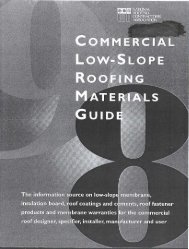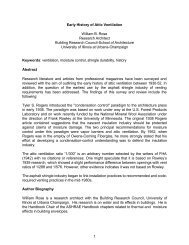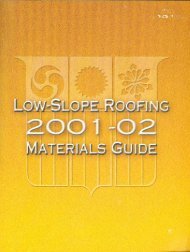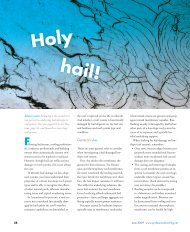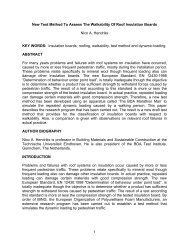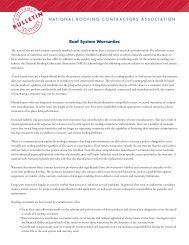Solar Safety
Solar Safety
Solar Safety
You also want an ePaper? Increase the reach of your titles
YUMPU automatically turns print PDFs into web optimized ePapers that Google loves.
<strong>Solar</strong> <strong>Safety</strong>Working with rooftop photovoltaic systemspresents fall-protection compliance issuesby Harry DietzRecent technological advances, improved aestheticsand valuable government incentive programs for photovoltaic(PV) roof systems have expanded their feasibilityto a wider variety of building types. If you install or areconsidering installing PV systems, you may find yourselfchallenged during the job-hazard analysis project phaseto determine Occupational <strong>Safety</strong> and Health Administration(OSHA) fall-protection rules applicable to PVroof system installations.In some cases, available fall-protection controls yourely on may not be applicable to PV system installations.The nature of the installation and the material used maydictate how you protect your workers from fall hazards.Fall-protection overview<strong>Solar</strong> <strong>Safety</strong>Fall protection in the U.S. roofing industry is required fall-protection systems also are required to protect otherunder federal OSHA jurisdiction Working by the with provisions rooftop found photovoltaic workers addressed systems in the construction regulations.in 29 CFR 1926.500-503, presents Subpart M. fall-protection However, though compliance However, OSHA issues rules applicable to roofing work onmost OSHA state-plan states have incorporated these low-slope roofs also allow a warning-line system in combinationwith one of the conventional fall-protection federal fall-protection regulations and their specificby Harryfall-Dietzsys-protection control systems into their rules for worker protection,some state-plan states such as Arizona, California,Kentucky, Michigan, NorthCarolina, Oregon and Washingtonhave unique fall-protection requirementsthat differ significantly from federal rules. In somestates, broader fall-protection system options for workersare available to select based on the nature of the work andhazards faced.OSHA construction regulations apply to work performedin a contract for construction, alteration or repair.Construction workers generally are required to use fall protectionwhen they are exposed to a potential fall distanceof 6 feet or greater. OSHA’s general industry rules addressmost workers in manufacturing, warehousing and otherbusiness classifications and mandate fall protection whenworkers are exposed to fall hazards of 4 feet or greater.Generally, roofing workers on slopes less than 4:12must be protected from falls at heights 6 feet or greaterby guardrail, safety net or personal fall-arrest systems—often called conventional fall protection. Conventionaltems or a warning-line and safety-monitoring system beused to protect workers from falls. On roofs 50-feet wide30 www.professionalroofing.net OCTOBER 2013
or less, a safetymonitoringsystem alone may be used.A critical factor when using fall-protection systems notconsidered conventional under OSHA rules is the workbeing performed must fall within OSHA’s “roofing work”definition. OSHA defines roofing work as the “hoisting,storage, application, and removal of roofing materials andequipment, including related insulation, sheet metal, andvapor barrier work, but not including the construction ofthe roof deck.”If work being performed on a low-slope roof systemdoes not fall within the roofing work definition, onlyconventional fall protection may be used to protect workersat heights 6 feet or greater. On slopes greater than4:12, only conventional fall protection may be used toprotect workers without regard to whether the work beingperformed meets the roofing work definition.However, on some residential steep-slope buildings,other fall-protection measures may be employed under theauspices of a written fall-protection plan if you show conventionalfall protection is infeasible or creates a greaterhazard. There is a presumptionconventional fall protection is feasible and willnot create a greater hazard and, accordingly, you havethe burden of establishing the controls provided in a fallprotectionplan are appropriate.PV fall protectionOSHA’s roofing work definition will be paramount whenproperly analyzing which fall-protection control systemsmay be used to protect workers during PV system installations.Because the definition references the applicationof roofing materials, OSHA is likely to consider roofintegratedPV system installations roofing work becausethe material being installed comprises the weatherproofingmembrane along with the PV component, or the PVcomponents are adhered directly to the roof membrane.But OSHA is less likely to consider rack-mounted PVarrays or panels installed on a weatherproofing membrane’ssurface as roofing material because they do notserve a weatherproofing function. OSHA clearly considersthe installation of flashings on frames for rack-mountedPV system components, conduits or other PV elementpenetrations roofing work.OCTOBER 2013 Professional Roofing 31
ON the WEBFor information about OSHA’s fallprotectioncampaign or to view theCalifornia Department of Forestry andFire Protection’s <strong>Solar</strong> PhotovoltaicInstallation Guideline, log on towww.professionalroofing.net.Similar distinctions apply to repair and maintenancework related to PV components. If the workinvolves a roof membrane’s integrity, OSHA morelikely will characterize it as roofing work. OSHAis likely to view repair or maintenance to PV componentsin racks or panels, structural or framingelements, raceways or conduits, or junction or combinerboxes that have no effect on a roof membrane’s integrityas outside the scope of the roofing work definition.In a vast majority of instances, the practical result ofthis distinction will be work involving roof-integratedsolar components because they comprise the actual roofmembrane or weatherproofing component, more clearlyfalling within the roofing work definition, allowing the useof warning-line and safety-monitoring systems. Directwork on other rooftop PV components, unlessperformed to ensure weatherproofing ofan underlying roof system, will requireone of the conventional forms offall protection under OSHArules because OSHA will notconsider the PV componentsroofing materials.The 15-foot ruleAn exception created by OSHAoften is referred to as the 15-foot rule. Under this rule, announcedby OSHA in a letter ofinterpretation in May 2000, OSHAsays certain physical barriers not meetingthe strength requirements for guardrails, such aswarning lines, may be used to contain a work area andwill be considered adequate fall protection if the followingfour elements are present:• The warning-line setup is at least 15 feet from aroof edge or a hole.• The warning line meets the criteria in OSHA’sregulations for warning-line strength and setup.• No work is allowed to take place outside contiguouswork areas created by warning lines.• The employer effectively implements a work ruleprohibiting workers from going outside the warningline (that is, closer to the roof edge or hole).This exception allows for the performance of a numberof repair and/or maintenance activities related toPV systems and other rooftop activities performed by avariety of construction trades without other forms of fallprotection.Fall protectionyou rely onmay not beapplicable toPV systemsPersonal fall-arrest issuesOf the conventional fall-protection options under OSHA’srules, personal fall-arrest setup and use may present somechallenges, especially for steep-slope building designs withcertain PV system installations. Lifelines, whether ropegrabor self-retracting, can present problems if PV systemcomponents impede deployment of the personal fall-arrestsystem.For example, if a PV rack’s structural framing pincheda self-retracting lifeline cable and restricted its retractingmotion before a worker’s fall or if additional lifeline hadto be played out to access areas, this could result in potentialincreased free-fall distances.Some resources designed to ensure firefighters’ safetywhen accessing roofs with PV systems in place duringfire emergencies have the additional benefitof assisting roofing contractors with fallprotectionsystem selection during PVsystem installations and repairs. The<strong>Solar</strong> Photovoltaic InstallationGuideline developed by the CaliforniaDepartment of Forestryand Fire Protection, Office of theState Fire Marshall in April 2008sets out nonmandatory guidelinesfor access areas and pathways forPV system installations on roofs.The guidelines are valuable becausethey provide clear roof perimeters at distancesfrom low-slope roof edges that alloweffective warning-line system setups with a sufficientwork area to perform necessary tasks while remaininginside the warning line. For steep-slope applications,access paths and perimeter guidelines also are establishedfor hip and gable roofs, which allow for more free movementof personal fall-arrest lifelines.Stay safeRoofing work involving PV systems can be accomplishedunder current OSHA regulatory requirements and fallprotectionoptions. However, such work presents someissues that you must meet to ensure fall-protection optionsare compliant. Understanding the specifics of OSHA’sSubpart M will help keep workers safe and PV systeminstallations trouble-free. 123Harry Dietz is NRCA’s director of risk management.32 www.professionalroofing.net OCTOBER 2013



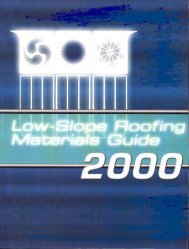
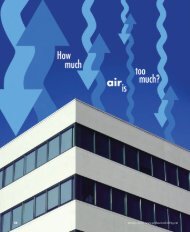

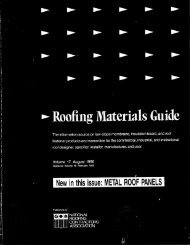
![Wm] - National Roofing Contractors Association](https://img.yumpu.com/36696816/1/190x245/wm-national-roofing-contractors-association.jpg?quality=85)

